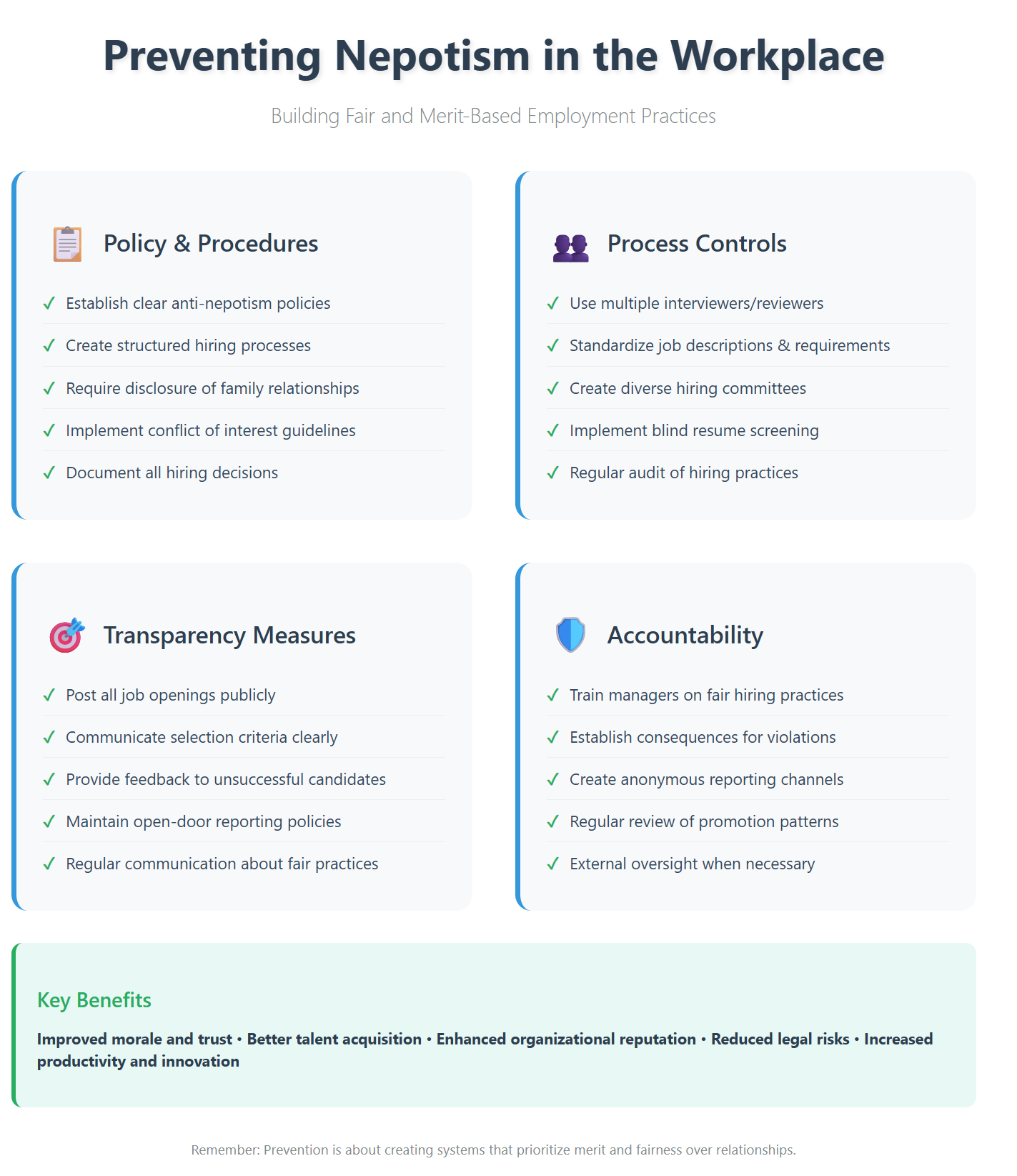Introduction
Nepotism in the workplace refers to favoritism shown to relatives or close friends, especially in hiring, promotions, and project assignments. While often subtle, its effects can be deeply damaging to morale, performance, and organizational trust.
Unchecked nepotism can lead to resentment, disengagement, and even legal risks. For organizations striving for fairness and equity, understanding how to prevent nepotism is essential.
This guide outlines research-backed strategies to create a transparent, inclusive, and merit-based culture that discourages favoritism at every level.
What Is Nepotism? (Definition & Examples)
Nepotism occurs when employees receive favorable treatment due to personal relationships rather than merit or performance.
Examples include:
- Hiring a CEO’s niece over more qualified candidates.
- Promoting a manager’s sibling without a formal review process.
- Assigning high-visibility projects to family members only.
Related terms:
- Cronyism: Favoring close friends or allies.
- Favoritism: Preferential treatment based on any personal bias.

Why Preventing Nepotism Matters
1. Morale and Productivity:
Employees who perceive unfairness are less engaged and more likely to underperform or leave.
2. Legal and Ethical Concerns:
Nepotism can expose companies to discrimination claims and damage employer reputation.
3. Long-Term Business Impact:
Favoritism limits diversity, stifles innovation, and leads to ineffective leadership pipelines.
Signs of Nepotism in the Workplace
- Promotions without transparent criteria.
- Family members dominating key leadership roles.
- Sudden policy changes to accommodate one person.
- Performance issues overlooked due to relationships.
- Team members reluctant to speak up or challenge decisions.
Step-by-Step Guide to Preventing Nepotism
1. Establish and Communicate Clear Policies
- Develop an anti-nepotism policy that outlines acceptable practices.
- Include disclosure requirements for relationships.
- Sample clause: “No employee shall be directly supervised by a family member or be involved in their evaluation.”
2. Promote Transparency in Hiring and Promotion
- Use standardized job descriptions and evaluation rubrics.
- Document and publish criteria for raises, promotions, and hiring decisions.
- Include diverse panels in decision-making processes.
3. Encourage Reporting and Protect Whistleblowers
- Set up anonymous reporting tools like hotlines or online forms.
- Enforce zero tolerance for retaliation against whistleblowers.
4. Provide Training and Leadership Development
- Offer bias-awareness training to all managers.
- Develop leadership programs based on merit, not relationships.
- Require ethics training during onboarding and annually.
5. Foster a Culture of Fairness and Inclusion
- Promote open feedback loops and regular surveys.
- Celebrate diversity and make equity part of core values.
- Review internal mobility practices for fairness.
6. Monitor and Audit Practices
- Conduct annual audits of promotions, performance reviews, and hiring.
- Use exit interviews and pulse surveys to detect favoritism.
- Adjust policies based on audit outcomes and employee feedback.

Real-World Case Studies
1. IBM implemented blind hiring practices, leading to increased diversity and reduced favoritism across departments.
2. A mid-size marketing agency introduced a rotating hiring panel and saw a 40% improvement in employee satisfaction scores within a year.
3. A public institution enforced a strict nepotism disclosure form, which led to the restructuring of several teams and a boost in performance metrics.
Lessons Learned:
- Clear documentation deters favoritism.
- Diversity in leadership decisions promotes equity.
- Employee feedback is a vital detection tool.
Frequently Asked Questions (FAQ)
Q1: What is nepotism in the workplace?
A1: Nepotism is the practice of showing favoritism toward family members in hiring, promotions, or work assignments, often at the expense of more qualified candidates.
Q2: How does nepotism affect employee morale?
A2: Nepotism can lower morale by creating perceptions of unfairness, leading to disengagement, reduced motivation, and higher turnover among employees.
Q3: Is nepotism the same as cronyism?
A3: No. Nepotism refers to favoritism toward family, while cronyism involves preferential treatment of friends or political allies, often in leadership or advisory roles.
Q4: What are common signs of nepotism in a company?
A4: Red flags include unqualified hires with family ties, rapid promotions without performance justification, and reluctance among staff to raise concerns due to fear of retaliation.
Q5: Are anti-nepotism policies legally required?
A5: Not always, but many organizations implement them voluntarily to ensure fairness, reduce legal risk, and align with ethical HR practices.
Q6: What should be included in an anti-nepotism policy?
A6: A good policy should define nepotism, require relationship disclosures, prohibit direct supervision among relatives, and outline enforcement and reporting procedures.
Q7: Can nepotism lead to legal consequences?
A7: Yes. While not always illegal, nepotism can result in discrimination claims, especially if it disproportionately disadvantages others based on race, gender, or other protected characteristics.
Q8: How can organizations detect nepotistic behavior?
A8: Regular audits of hiring and promotion patterns, anonymous employee surveys, and HR compliance reviews can help identify favoritism or biased decision-making.
Q9: What role does transparency play in preventing nepotism?
A9: Transparency ensures that hiring and promotion decisions are based on merit. Public job postings, standardized evaluations, and panel interviews help minimize bias.
Q10: What are the long-term benefits of preventing nepotism?
A10: Preventing nepotism fosters trust, boosts employee engagement, supports diversity, strengthens leadership pipelines, and contributes to sustained business performance.
Conclusion
Preventing nepotism is critical to fostering a transparent, ethical, and high-performing workplace. By implementing structured policies, encouraging open dialogue, and holding leaders accountable, organizations can eliminate bias and promote true meritocracy.
